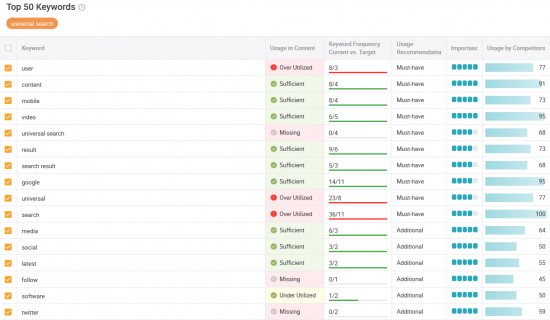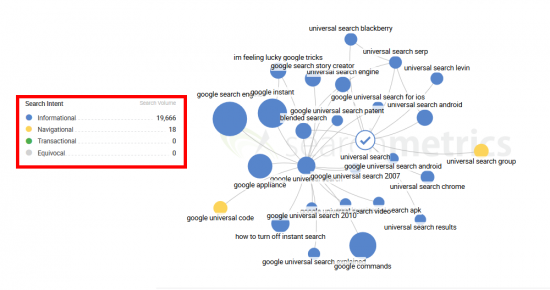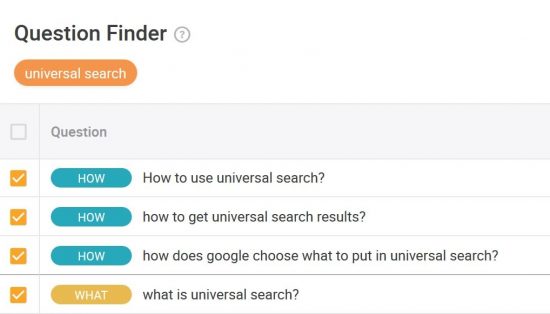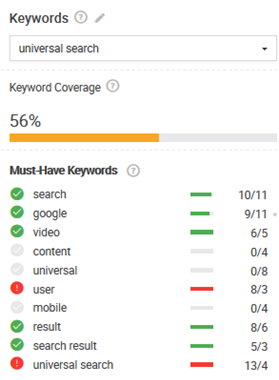One of the features of our new Searchmetrics Content Experience (SCE) we’re particularly proud of is the way it raises the efficiency of collaboration throughout an organization. This is obviously a huge benefit for the content owner, the person responsible for publication, but what about for the writers themselves? Here, we explore what it’s like working with the SCE from the writer’s point of view, and show you how it can make content writing less frustrating and more effective, without inhibiting personal creativity.
Change we can believe in
Since we’ve had the Searchmetrics Content Experience (SCE), we’ve obviously started using it to develop and refine our own content. Using our page on Universal Search as an example, I’ll run you through the process and show you how SCE won’t change your soul as a writer, but how it will change the way you approach content creation. For the better.
Trying something new – particularly when it affects your creative work – always requires a certain amount of openness. But ultimately, changes and improvements are always essential for increasing output and making processes more efficient. Typewriters have retro appeal but most people would recognize the benefits of modern word processors. Where would we be today without Ctrl + Z?
And in this case, from the very first look at the Searchmetrics Content Experience, it was clear straight away that it was offering something new that could:
- save time,
- streamline research and
- improve collaboration.
Disclaimer: In many cases, the following steps of content development may be carried out by different people – this workflow is also covered by the software. Just for this demonstration I went through all processes myself.
1. Discovery: Building a brief with the topic explorer
The foundation of any content piece created with the SCE is the brief. Once you’ve chosen your topic and language, you move on to the topic explorer.
Here, the software lets you look at and click your way around related subjects, providing ideas for what to include in your text. This is a great way of starting out your research, as it instantly throws up related topics and lets you easily plan the direction you want your text to take.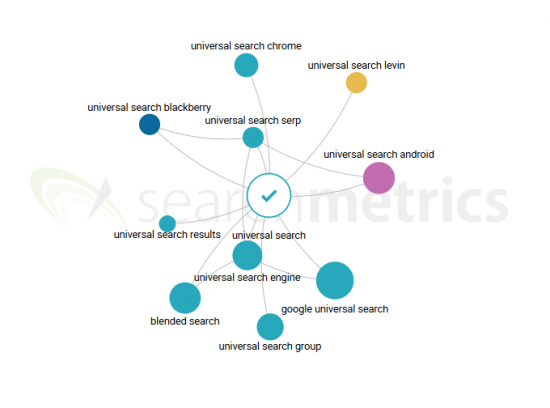
Two topics floating around near mine were “universal search android” and “universal search blackberry”. Whilst I didn’t want these to be a key focus of the text, this automatically made me think about possible differences across operating systems.
This is a really nice aspect of the topic explorer. It’s useful even if you don’t end up selecting many suggested topics to be your text’s main focus. As the name suggests, it really lets you explore the topic and think about what this piece of content can and should cover. And it can also draw your attention to related topics that could be deserving of their own landing page.
Staying on topic with relevant keywords
Once you’ve settled on your chosen topic, in my case, “universal search”, you’re presented with a list of 50 keywords that should signal to Google that this is a relevant text. Most of these were obviously good matches. I only deselected a couple, “netflix” and “apple tv”, and all the other suggestions went into the brief. Whilst it is possible to draw up keyword lists manually, or semi-manually (pivot table klaxon!), it’s so much easier having the list generated for you, particularly as it lets you focus your attentions on what you’re paid to do: write the actual content.
Other aspects of the topic explorer, like the seasonality of keywords and the search intent of users, can be a great guide when planning the overall content calendar.
As a writer, I’m personally more focused on the task at hand, but it’s still helpful to see what people are likely looking for when they find my page, and when they are probably going to be looking for it. With this piece about universal search, we were looking for an evergreen piece, not related to any particular time of year, and the user intent would be largely informational. This was backed up by the indicators in the software.
What kind of help does the Searchmetrics Content Experience provide?
Good content answers users’ questions. So one of a writer’s main jobs when planning a text is thinking about what questions readers might be asking. Here, the SCE helps you out. For my topic, the software suggested questions like “how to use universal search?” and simply “what is universal search?”
The list of questions, ordered by question word, gives you a direct idea of what people might be trying to find out. What are they looking for? What is their search intent? This lets you ponder and decide which questions you want your content piece to answer. I found several questions I thought it would be good to address with my content piece. You don’t have to write an FAQ, but if you know what information people are looking for, then you can make sure they can find it. This helps ensure you write something relevant: for Google and for users.
Selection of questions proposed by the Question Finder.
2. Brief complete – now let there be content
With the brief set up, the SCE takes you on to the content editor. As a writer, this is the bit I had been most looking forward to. The great thing about working with the SCE, as was evident almost immediately, was that it was helpful, yet not intrusive. The list of “must-have” and “additional” keywords was detailed enough to be worthwhile, without rigidly imposing itself on my text.
As I typed naturally, I could see the keyword bars gradually filling up, and I found myself not being forced, but gently – almost subconsciously – nudged in the direction of certain terms. As I was optimizing an existing page, the content already covered several of the required keywords, but some, like “content” and “mobile” were missing completely. This was something I could use to help guide my rewriting of the piece.
Writers gonna write write write write write
Like any writer, I like writing what I want to write and how I want to write it. Having a detailed brief is great – you need to know what the text is supposed to be about – but you don’t want someone looking over your shoulder, sniffing at your syntax, tutting at your typos and coughing at every comma. And grimacing at your attempts at alliteration.
Which is why I’m happy to tell you that the SCE is designed to effectively replace five people and their ten opinions with one reliable, consistent, data-driven voice of criticism. And another great thing – it speaks to you in real time.
Content Score – it’s not the Nobel Prize for Literature, but it’s still nice to win
The effect of the Content Score is similar. It’s not your main focus while writing. You can happily concentrate on whacking your text into the keyboard, but as a writer you have natural pauses where you look up from the keyboard, stare out of the window, maybe blow your nose. And when working with the SCE, your eyes naturally glance over at the Content Score, the list of keywords and the suggested questions. These don’t make you panic, but they act as little reminders or inspiration for the next paragraph.
With the text on universal search, the Content Score when I started was at 69%, but as I started improving the content, taking the keyword recommendations into account but also adapting it to my style and expanding the topic, the score went up fairly rapidly to over 85%. By the time I was finished, it was at 91%. This is obviously a nice feeling for any writer. Everyone likes to win.
Less rewriting for a more rewarding experience
Once the first draft is done, you can look more closely at the keyword coverage lists, and see in real time exactly how you’re getting on. In my example, I found some terms which I hadn’t included or were underrepresented. A few, like “twitter” and “comment”, would certainly be relevant for some texts on universal search, but I didn’t see any need to shoehorn them in to mine. And the SCE gives the writer enough editorial freedom to say, “no thank you”. It lets the writer write.
And because you have the targets set in the brief, you know that your draft unambiguously fulfils the criteria your manager is looking for. With the SCE, you don’t have to draft, submit, get feedback, redraft, resubmit, get new feedback (that may contradict the previous one), rinse and repeat.
This measurability means less back-and-forth, less rewriting and, ultimately, a more rewarding experience for everyone involved. That’s why writers are going to love working with the SCE.
3. Easy export – tailor-made for swift online publication
Previously, don’t tell anyone, but I have mainly used Word to compose texts. Whilst this has meant that I am comfortable writing the text, it has also meant that I always need to completely reformat when uploading to our CMS. An editing tool with enough other benefits to drag me away from Word would be highly welcome.
The Searchmetrics Content Experience certainly offers these benefits. And to top it off, when your text is done, it’s a refreshing change to have a ready-formatted HTML code. After exporting, you have a text that is ready to go live.
Sign up to a new way of writing
As a writer, once you open up to working with the SCE, you feel instructed, not directed, inspired, not restricted. I don’t mind admitting that texts I write probably turn out better and more on-point than when doing them freestyle. They certainly get researched, written and approved faster, and with a Content Score over 90%, the page on universal search does rank nicely near the top of Google’s results.
So the SCE not only helps you craft content that is better at meeting users’ needs, it also improves the writing experience by offering qualified, data-based guidance without hampering your creativity. I recommend it to any writer who prefers to spend their time writing really well, rather than working really hard.



